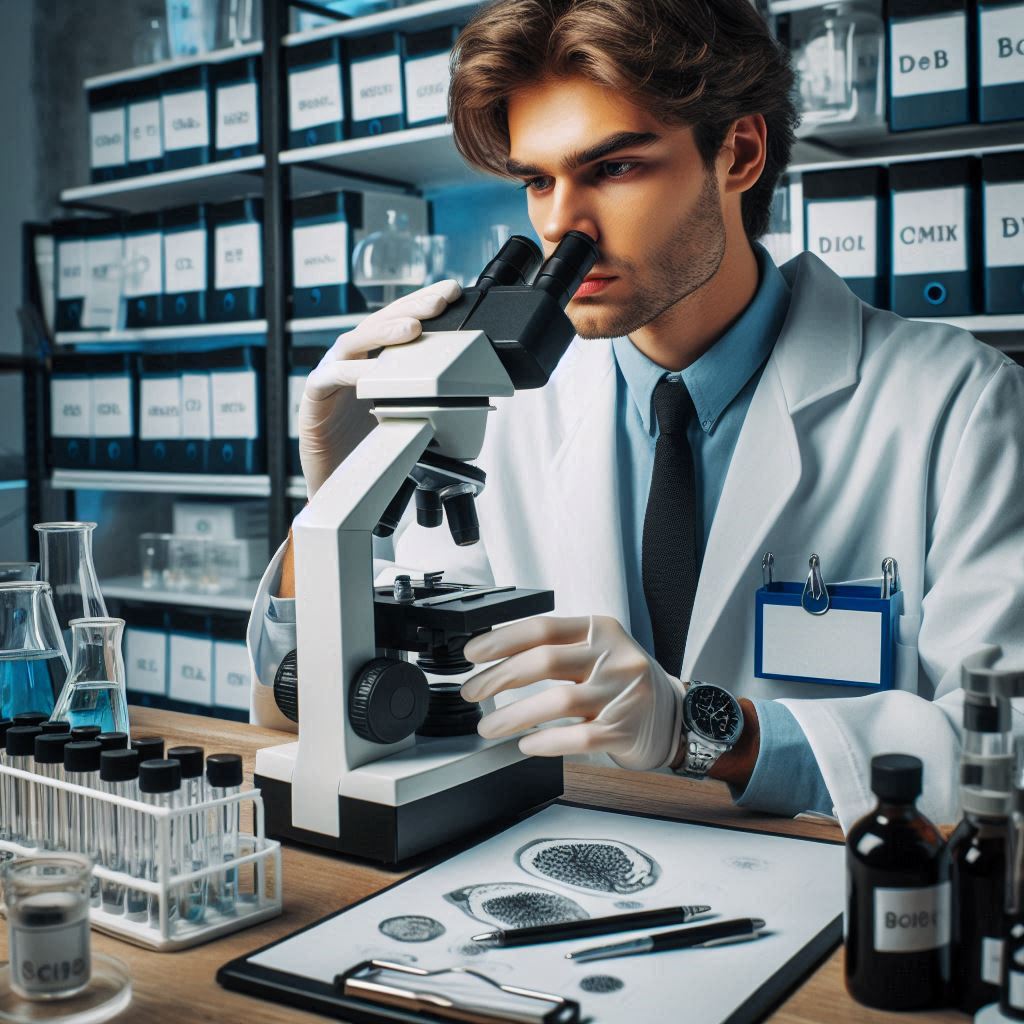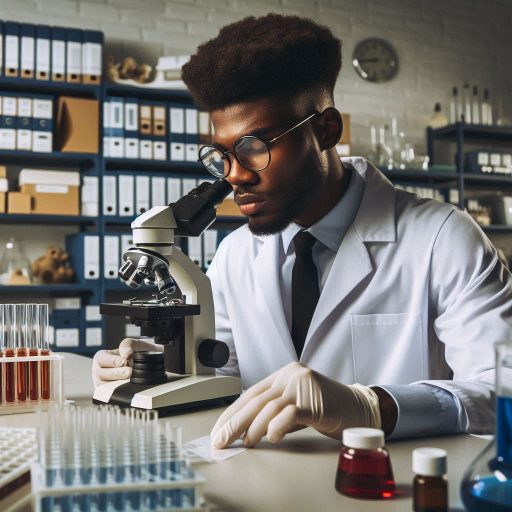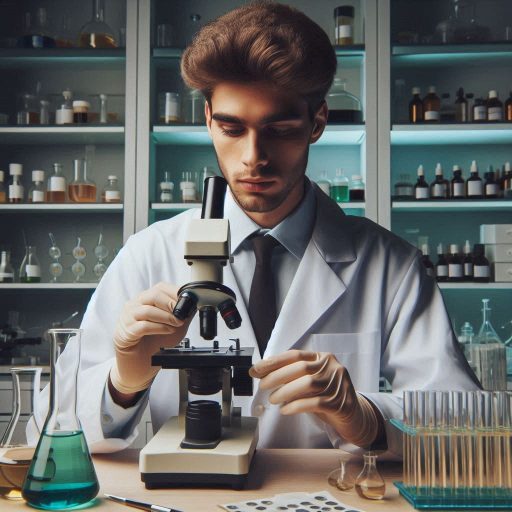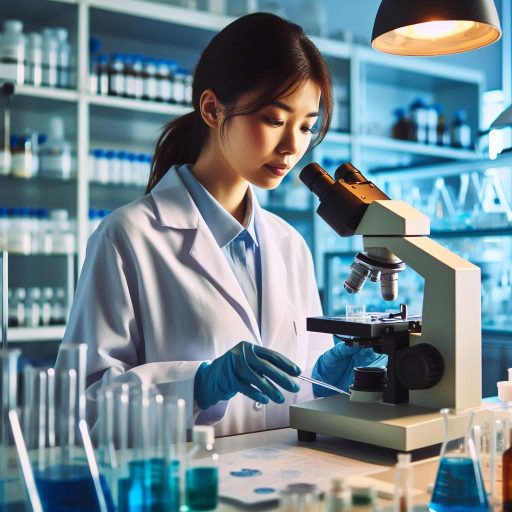Introduction
Forensic science involves the application of scientific knowledge to aid in criminal investigations. It uses various techniques to analyze evidence.
Cold cases are unsolved criminal investigations that have remained open for an extended period, often years or even decades.
Impact of Forensic Science on Cold Cases
Forensic science has revolutionized the way cold cases are approached and solved.
Through advancements in DNA analysis, cases that were once considered unsolvable are now being reopened and investigated with new leads.
One of the key ways forensic science has impacted cold cases is through the use of DNA technology.
DNA evidence can now be collected and analyzed from crime scenes, leading to the identification of suspects or victims even years after the crime occurred.
Forensic scientists also utilize techniques such as fingerprint analysis, ballistics, and trace evidence examination to link suspects to crimes in cold cases.
These methods provide crucial evidence that can help solve cases that have long been considered unsolvable.
Furthermore, the development of forensic databases and software tools has made it easier for law enforcement agencies to share and compare data across jurisdictions.
This has led to the solving of cold cases by connecting evidence from different crime scenes and identifying patterns that were previously undetected.
Essentially, forensic science has had a significant impact on cold cases by providing law enforcement with new tools and technologies to solve previously unsolvable crimes.
As technology continues to advance, the potential for solving cold cases using forensic science will only continue to grow.
Advancements in Technology
DNA Analysis
Advancements in forensic science technology have revolutionized how investigators approach cold cases.
One of the most impactful innovations is DNA analysis, which has transformed criminal investigations.
By comparing DNA samples from crime scenes to national databases, investigators can identify suspects who were previously unknown.
Even in cases where DNA was improperly collected decades ago, modern methods allow for the extraction of viable samples.
DNA analysis can also eliminate suspects who were wrongly accused, bringing justice to those affected.
For example, the exoneration of individuals falsely imprisoned for years has gained new momentum thanks to DNA technology.
As forensic labs become more equipped with advanced tools, the reliability and speed of DNA testing continue to improve.
Fingerprints and Ballistics
Fingerprints, too, play a pivotal role in solving cold cases.
Technological advancements now allow for the recovery of partial or degraded fingerprints from old evidence.
Once considered unusable, these prints can now be analyzed and matched through improved databases.
Automated fingerprint identification systems (AFIS) have allowed detectives to identify potential matches across various jurisdictions.
Ballistics technology has also seen significant progress.
Modern software can analyze bullets and casings in ways that were impossible in previous decades.
New comparison systems match spent bullet fragments with firearms used in past crimes.
Investigators can now link a single gun to multiple crime scenes, uncovering connections that went unnoticed in earlier investigations.
Facial Recognition Software
Facial recognition software has emerged as another powerful tool in solving cold cases.
By analyzing photos or video footage from crime scenes, this technology can identify suspects even years later.
Law enforcement can compare facial features from cold case files to current databases, yielding possible matches.
While this technology is not without limitations, its ability to quickly scan and analyze large amounts of data has proven invaluable in re-opening old investigations.
In many cases, forensic advancements have helped solve decades-old crimes that once seemed unsolvable.
As these technologies become more precise and accessible, law enforcement agencies are reopening long-dormant cases with fresh hope.
DNA, fingerprints, ballistics, and facial recognition software offer investigators a suite of tools to crack cold cases that had gone cold for years.
These advancements not only increase the chances of solving cold cases but also provide closure to families of victims.
By bringing justice to cold cases, forensic technology continues to push the boundaries of criminal investigations.
Read: Profiles in Success: Leading Chemists of the 21st Century in the US
Solving cases decades later
Examples of Cold Cases Solved Using Forensic Science
Forensic science has revolutionized the way cold cases are solved, offering hope to families seeking justice.
Decades-old cases that once seemed impossible to crack are now being revisited and solved.
Thanks to advancements in DNA technology, investigators can now analyze evidence that was previously unusable or incomplete.
One remarkable example is the case of the Golden State Killer.
For over four decades, law enforcement hunted the man responsible for numerous murders and assaults.
However, it wasn‘t until 2018 that DNA evidence, analyzed through forensic genealogy, led to Joseph James DeAngelo‘s arrest.
The use of DNA from a genealogy website helped trace his family tree, ultimately identifying him as the killer.
This breakthrough gave closure to countless victims and their families who had lived in fear for years.
Another notable case solved with forensic science is the 1977 murder of Carla Walker.
She was abducted and killed in Texas, and for years her case remained unsolved.
Advances in DNA technology led to the arrest of Glen Samuel McCurley in 2020.
Investigators had preserved DNA from the crime scene, and when tested against McCurley‘s DNA decades later, it was a match.
This brought long-awaited justice to Carla‘s family, who had spent years seeking answers.
In 2021, the 1991 murder of Angie Dodge was solved after years of dead ends.
New DNA evidence led to the exoneration of a wrongfully convicted man and the arrest of the actual perpetrator, Brian Dripps.
The case had plagued detectives for decades, but with new forensic tools, they finally solved the crime.
For Angie‘s mother, who had tirelessly advocated for her daughter, this brought both justice and relief.
Closure for Families and Victims
These examples demonstrate the power of forensic science in bringing justice even decades after a crime.
It also highlights the importance of preserving evidence, as it can become the key to solving cold cases in the future.
As forensic technology continues to evolve, more cold cases will likely be revisited, giving families the answers they‘ve long sought.
For families and victims, these breakthroughs provide a sense of closure.
They no longer have to live with uncertainty or wait for justice.
The ability to solve cases decades later doesn‘t erase the pain, but it does offer a form of resolution.
For many, knowing that the perpetrator is finally held accountable is a crucial step in healing.
Forensic science has given hope where once there was only despair, showing that justice delayed is not always justice denied.
Read: The Life and Times of a U.S. Physicist: A Day in Detail
Reopening Old Cases
Forensic science has revolutionized the reopening of cold cases by uncovering potential suspects through new evidence.
Advances in DNA testing, fingerprint analysis, and digital forensics have breathed new life into investigations once deemed unsolvable.
With these advancements, law enforcement agencies are now able to re-examine evidence collected years or even decades ago, identifying potential suspects who previously evaded detection.
Potential Suspects Identified Through New Evidence
DNA testing has become one of the most significant tools in solving cold cases.
Initially, many cases lacked the technology to process DNA samples, or the available technology was limited.
However, modern DNA techniques can now extract usable genetic material from tiny or degraded samples.
This powerful tool has led to the identification of numerous suspects, even in cases that were dormant for decades.
For example, many cold cases have been solved after matching old DNA samples to suspects via national DNA databases.
Fingerprint analysis has also evolved, becoming more accurate and reliable over time.
Previously, investigators might have found fingerprints at a crime scene but lacked the tools to match them to a suspect.
New digital tools allow forensic teams to analyze and compare prints with far greater precision.
This can uncover previously missed connections between suspects and crime scenes.
Re-Evaluating Witness Statements and Alibis
In addition to physical evidence, forensic science plays a vital role in re-evaluating witness statements and alibis.
Memory tends to fade over time, but modern technology can verify or debunk earlier testimonies.
For example, digital forensics can now track mobile phone data, online activity, or surveillance footage that either supports or contradicts previous alibis.
This new information often leads to fresh insights into the sequence of events, providing a clearer picture of what actually happened.
In some cases, witness statements are re-examined using forensic linguistics, which analyzes speech patterns, word choice, and writing styles.
This method can reveal inconsistencies in witness statements or highlight areas where a witness may have lied or been coerced.
Forensic psychologists also play a role in helping to understand the reliability of witness testimony and may offer expert opinions on the mental state of those involved.
Reopening cold cases also provides closure to victims’ families, who often go decades without answers.
Through forensic advancements, long-awaited justice can be served.
Many law enforcement agencies now maintain dedicated cold case units, focusing solely on solving old cases with new evidence and techniques.
The impact of forensic science on cold cases has reshaped how justice is pursued, giving hope that no crime is ever truly forgotten.
Read: Salary Ranges: What to Expect as a Physicist in the USA

The Importance of Evidence Preservation in Cold Cases
Preservation of Physical Evidence
The preservation of evidence plays a critical role in solving cold cases.
Physical evidence is often the key to unlocking the truth in cases that have gone unsolved for years.
Proper preservation of physical evidence ensures that it remains intact and viable for future analysis, even when years have passed since the crime occurred.
Forensic advancements have allowed old evidence to be reexamined with more advanced technologies, such as DNA testing and digital forensics.
However, these technologies are only useful if the evidence has been well-preserved.
Maintaining the integrity of physical evidence begins at the crime scene.
Evidence must be collected, packaged, and stored in a way that prevents degradation.
Items such as blood samples, fingerprints, and trace materials can degrade or lose their evidentiary value if not properly handled.
For instance, blood evidence must be stored in a temperature-controlled environment to prevent decomposition.
Likewise, other physical evidence must be kept in secure, dry environments to maintain its integrity.
Chain of Custody Procedures
Another essential element of evidence preservation is maintaining the chain of custody.
The chain of custody refers to the chronological documentation or paper trail showing the collection, handling, and storage of evidence.
This process ensures that the evidence has not been tampered with, misplaced, or contaminated.
Proper chain of custody procedures provide transparency and establish credibility when the evidence is presented in court.
It shows that the evidence remained in secure hands from the moment it was collected to when it is analyzed and presented.
Preventing Contamination
To prevent contamination, law enforcement personnel must follow strict protocols.
Contamination can happen if those handling the evidence do not wear protective gear or fail to follow procedures.
For example, without gloves, officers may leave their fingerprints on evidence, compromising its use in forensic testing.
Additionally, cross-contamination can occur when different pieces of evidence are stored together or not properly separated.
Preventing contamination preserves the integrity of the evidence and ensures that it reflects only relevant information from the crime scene.
Cold cases often rely on evidence that was gathered years, or even decades, earlier.
Preservation and chain of custody procedures help maintain the reliability of this evidence over time.
Advances in forensic science can only unlock new insights if the original evidence remains uncontaminated and traceable.
By ensuring proper preservation and handling, law enforcement maximizes the chances of finally bringing justice to cold cases.
In essence, preserving physical evidence, maintaining a secure chain of custody, and preventing contamination are crucial steps in solving cold cases.
These practices ensure that evidence remains viable for forensic analysis, even years later.
Read: Physics Specializations: Choosing Your Path in the U.S.
Challenges Faced in Solving Cold Cases
Cold cases present unique challenges, making it difficult for investigators to solve them even with modern tools.
Deterioration of Evidence Over Time
One of the primary challenges is the deterioration of evidence over time.
Physical evidence, like DNA, fingerprints, or fibers, may degrade or disappear.
Environmental factors, such as exposure to moisture, heat, or improper storage, can also affect the integrity of the evidence.
In some cases, crucial evidence may have been mishandled, further complicating its usefulness in solving the crime.
Transform Your Career Today
Unlock a personalized career strategy that drives real results. Get tailored advice and a roadmap designed just for you.
Start NowLack of Technology at the Time of the Crime
Another significant hurdle is the lack of technology at the time of the crime.
Decades ago, investigators did not have access to advanced forensic tools like DNA profiling or digital databases.
Consequently, some key evidence may not have been collected, processed, or preserved properly due to outdated techniques.
Back then, solving crimes relied heavily on eyewitness testimony or circumstantial evidence, which is often unreliable.
Without modern forensic science, crucial connections between the perpetrator and the crime were often missed.
Finding New Leads and Witnesses
The passage of time also makes finding new leads and witnesses increasingly difficult.
Witnesses‘ memories fade, and in some cases, they may pass away or become impossible to locate.
Without fresh testimony or new tips, investigators struggle to uncover new information.
Fear of retaliation, especially in violent or gang-related cases, can also prevent witnesses from coming forward, even years later.
The older the case, the more likely that key people involved have moved, changed names, or have no incentive to participate in the investigation.
Investigators face additional complications when the original suspects or persons of interest cannot be found.
People connected to the case may have relocated or changed their identities, making them harder to track down.
Moreover, societal changes over time can influence public interest in the case.
What was once a highly publicized crime may fade from collective memory, reducing the likelihood of anyone stepping forward with new information.
In cold cases, police resources are often stretched thin.
Investigators may prioritize newer cases, leaving less time and attention for unsolved ones.
Cold cases usually require extensive time, funding, and personnel to reopen and investigate properly.
This lack of resources can slow down or even halt the progress on solving older cases.
Despite these challenges, advances in forensic technology and renewed interest in justice provide hope for solving cold cases.
Every piece of evidence that survives time could lead to new breakthroughs when re-examined with modern methods.
However, overcoming the deterioration of evidence, outdated technology, and elusive witnesses remains a daunting task.
families and bringing perpetrators to justice.
Combating wrongful convictions
Exonerating Innocent Individuals Through DNA Testing
Forensic science has played a crucial role in combating wrongful convictions, offering new hope to innocent individuals.
DNA testing, one of the most powerful forensic tools, has exonerated many wrongly convicted people.
By analyzing biological evidence, forensic scientists can confirm or challenge previous conclusions drawn from investigations.
DNA testing has not only helped solve crimes but has also revealed numerous wrongful convictions over the years.
Exoneration through DNA testing has shed light on flaws in the criminal justice system.
Many wrongful convictions occur because earlier cases lacked advanced forensic methods.
Biological evidence, such as blood, saliva, or hair, was often mishandled or improperly analyzed in the past.
Now, forensic experts can re-examine this evidence using modern techniques, often proving the innocence of those convicted.
DNA tests have cleared many individuals who spent decades behind bars for crimes they did not commit.
One of the most notable cases of wrongful conviction exoneration is that of Kirk Bloodsworth.
In 1993, Bloodsworth became the first American on death row to be exonerated through DNA testing.
He had been convicted of the rape and murder of a young girl, based on witness testimony and circumstantial evidence.
However, DNA testing ultimately cleared his name, proving the power of forensic science to correct past errors.
Since then, hundreds of individuals have been freed after similar tests revealed they were wrongfully convicted.
Uncovering False Confessions or Coerced Testimonies
Forensic science has also played a key role in uncovering false confessions and coerced testimonies.
Wrongful convictions are sometimes based on these false confessions, often made under duress or pressure.
Innocent individuals, fearing harsher penalties, sometimes confess to crimes they did not commit.
In such cases, forensic evidence has exposed the truth, helping to overturn these convictions.
DNA evidence, in particular, has contradicted false confessions, highlighting discrepancies between a suspect‘s testimony and the actual crime scene.
Coerced testimonies from witnesses or suspects have also led to wrongful convictions.
These testimonies can result from manipulation or intimidation by law enforcement or attorneys.
Forensic science helps uncover the truth in these situations, often proving that these testimonies were fabricated or unreliable.
By analyzing physical evidence like fingerprints, fibers, or DNA, forensic experts provide objective findings that challenge false testimonies.
In summary, forensic science has been instrumental in combatting wrongful convictions.
Through DNA testing, the innocent are exonerated, while false confessions and coerced testimonies are exposed.
As forensic techniques continue to evolve, their impact on rectifying judicial errors will grow, offering more individuals the chance for justice.
Training and Education in Forensic Science
Importance of Properly Trained Forensic Experts
Proper training in forensic science is crucial for solving cold cases and ensuring accurate criminal investigations.
Forensic experts analyze complex evidence that requires specialized knowledge and skills to interpret correctly.
Without proper education, errors can occur, potentially leading to wrongful convictions or unsolved crimes.
Properly trained forensic experts provide invaluable contributions to investigations.
Their specialized training allows them to handle and analyze evidence accurately, including DNA, fingerprints, and digital data.
They understand the importance of maintaining chain-of-custody protocols, ensuring that evidence is preserved without contamination.
This helps courts rely on forensic findings, increasing the likelihood of solving cold cases.
Accreditation and Certification Programs
Accreditation and certification programs help establish the credibility of forensic professionals.
These programs ensure that experts meet high standards in their field and possess up-to-date knowledge.
Certification, such as from the American Board of Criminalistics (ABC) or the International Association for Identification (IAI), serves as a marker of competence.
It shows that forensic experts have undergone rigorous testing to demonstrate their proficiency in specific areas of forensic science.
Continuing education and professional development are essential in forensic science.
Many organizations offer training programs, workshops, and conferences to keep professionals updated on new tools and methodologies.
Forensic experts who continually expand their knowledge stay ahead of the curve, ensuring that they can bring the most cutting-edge techniques to investigations.
This is particularly important for cold cases, where innovative approaches might be the key to uncovering new evidence.
Keeping Up with Evolving Technologies
Forensic science is constantly evolving, and staying current is critical for experts in the field.
New technologies, such as advanced DNA testing, can offer new ways to examine old evidence.
Cold cases often benefit from these advancements, providing fresh leads and solving mysteries that once seemed impossible.
Forensic scientists must stay informed about these technological breakthroughs to apply the latest techniques effectively.
Evolving technologies are reshaping forensic science, and experts must adapt quickly to remain effective.
Training in digital forensics, 3D imaging, and other emerging areas is becoming increasingly important.
As criminal investigations grow more complex, forensic professionals need diverse skills to tackle new challenges.
Cold cases, which may have outdated or insufficient evidence, often rely on these new technologies for breakthroughs.
Accreditation programs, ongoing education, and technological proficiency are critical for modern forensic experts.
By maintaining high standards of training, they contribute significantly to resolving cold cases and delivering justice.
Properly trained experts, equipped with the latest tools, ensure that even the most challenging cases have a chance of being solved.
Learn More: Balancing Fieldwork and Research in Archaeology
Gain More Insights: Epidemiology Research Methods: An Introduction
Find Out More: Day in the Life of a Microbiologist Explained
Conclusion
Forensic science has transformed cold case investigations, breathing new life into cases that once seemed unsolvable.
With advances in DNA testing, forensic technology, and analytical techniques, detectives can revisit old evidence with new hope.
In recent years, countless cold cases have been reopened and solved, bringing long-awaited justice to victims and closure to their families.
The role of DNA testing is particularly groundbreaking.
It allows investigators to match previously unidentifiable samples with individuals in modern databases.
Many cold cases that remained dormant for decades have been solved thanks to this crucial tool.
Fingerprint analysis, ballistic testing, and digital forensics have also played pivotal roles in reopening cases, offering new insights into old evidence.
Forensic science has not only identified perpetrators but also exonerated the wrongfully convicted.
In several instances, individuals who spent years in prison for crimes they did not commit were freed due to advances in forensic methods.
This highlights the importance of continually improving forensic techniques to ensure accuracy and justice in every case.
Cold case investigations have become more sophisticated thanks to the evolution of forensic science.
However, there is still much room for growth in this field.
Technologies like genetic genealogy and artificial intelligence are expanding the horizons of forensic science.
These advancements hold the potential to revolutionize investigations further, especially when it comes to cold cases that lack clear leads.




